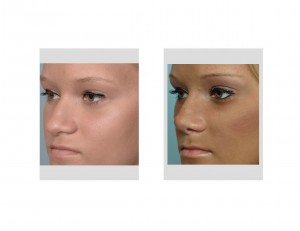One of the key features of an attractive and youthful face is the cheek area. The desire for fuller cheeks, however, is driven more than just by that of model and celebrity faces. Part of the aging process is losing volume (fat) in the cheeks and temple areas, creating more hollowed or gaunt type look. For those that start out with thinner faces, this process is more accentuated even earlier in the aging process. This form of facial aging can not be treated by any form of a facelift or tissue shifting approach. It requires restoration of facial volume.
So it is no surprise that plastic surgeons over the years have used every available option in their armamentarium to reshape and lift the cheek area. While once only able to be treated by synthetic implants up to the early 1990s, injectable fillers of differing compositions for cheek enhancement became a dominant force over the past two decades as they have surged in popularity. The use of autologous fat in just a few short years has also become now a major tool for use in the cheek.
The single greatest advantage to synthetic injectable fillers for cheek enhancement is its immediate result. The hyaluronic acid-based fillers, such as Restylane or Juvederm, offer the greatest margin of safety because of their lack of inflammatory response and assured resorption profiles. Other fillers such as Radiesse and Sculptra offer longer results but a somewhat higher risk of soft tissue reactions to their particulated content. Composition aside, the biggest disadvantage to fillers is that they are temporary. (which is also their advantage) This makes them expensive to maintain over time if one likes the result. But they are actually a low cost approach to doing a trial cheek enhancement that is completely reversal. Using a microcannula delivery technique, injectable fillers can now be delivered painlessly and without bruising.
On the surface, fat carries with it many of the same features as synthetic materials because it is injected. But beyond being injectable, it is a very different filler material. Because it is harvested from each individual patient, there is no chance of any inflammatory reaction and a very low risk of infection. It’s other tremendous advantage is that there is no limit on the volume that can be injected (in the small face) and its inherent composition of stem cells has its own list of theoretical advantages. In addition, it is done for a set procedure price rather than by a cc cost for synthetic fillers. It is similarly injected by small cannulas so placement can be very exact without bruising. The best fat placement is down at the bone level and in the muscle, where survival is better. But with all these advantages comes two distinct disadvantages…it is a minor surgical procedure and there is no assurance as to how much fat will survive. For these reasons, fat grafting is often advocated when the patient is in surgery for other procedures (e.g., facelift, lkipsouction etc) or the patient has been previously qualified by having had successful cheek augmentation with synthetic fillers.

With three cheek augmentation options available, how does any patient know what is best for them? Cheek augmentation is a lot more art than it is science and appreciating the underlying bony anatomy, the overall facial shape and what look the patient is after is key. But you have to take the whole patient into analysis not just the cheeks. Thin people with low body fat may do poorly with fat grafting, the devout non-surgery patient can only have synthetic fillers, or those seeking the most efficient and long-term method may opt for implants. Good cheek results defy a cookie-cutter approach and the most natural outcomes come from knowing how to use all three…occasionally even blending two of the techniques together.
Dr. Barry Eppley
Indianapolis, Indiana


